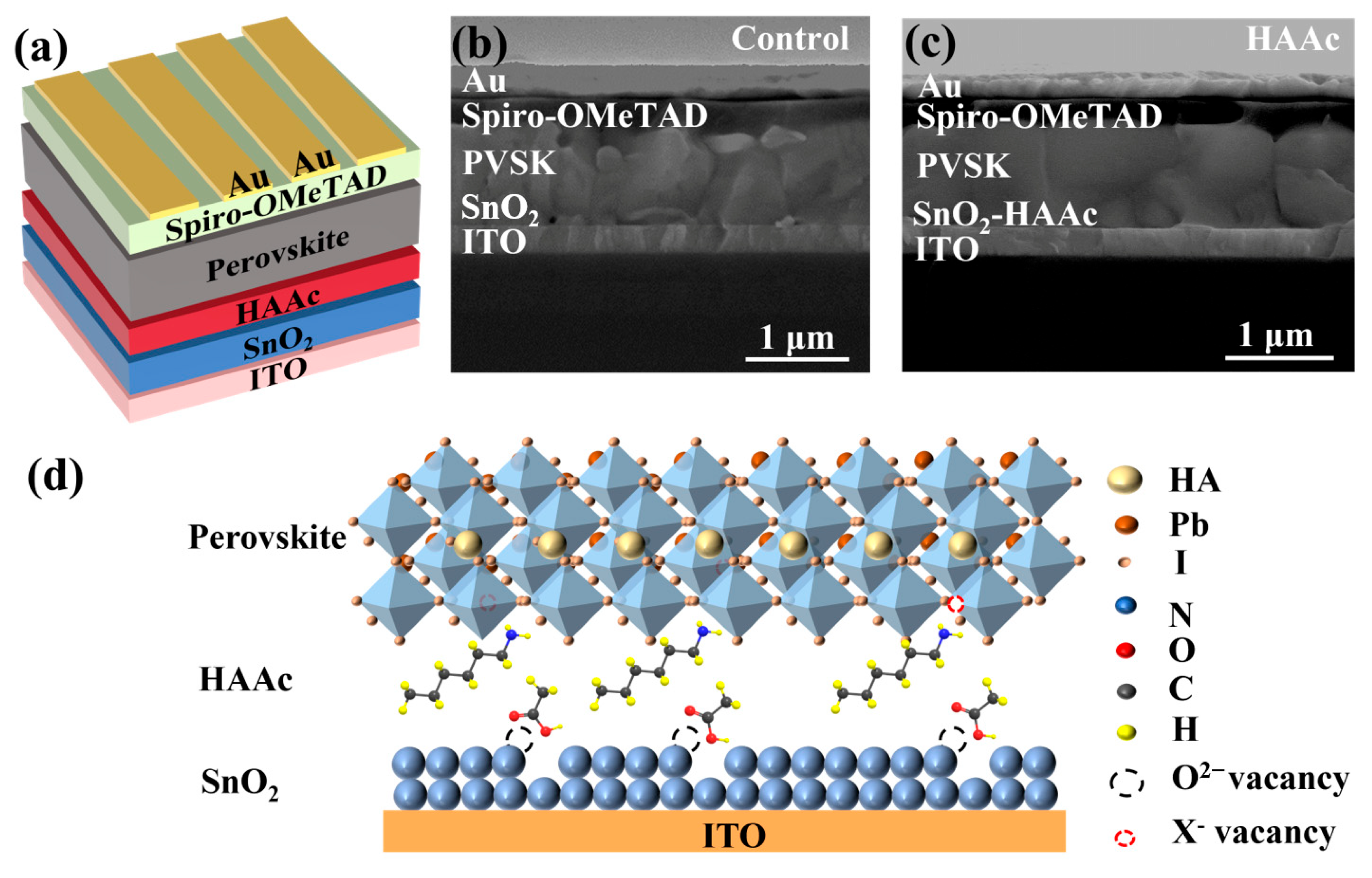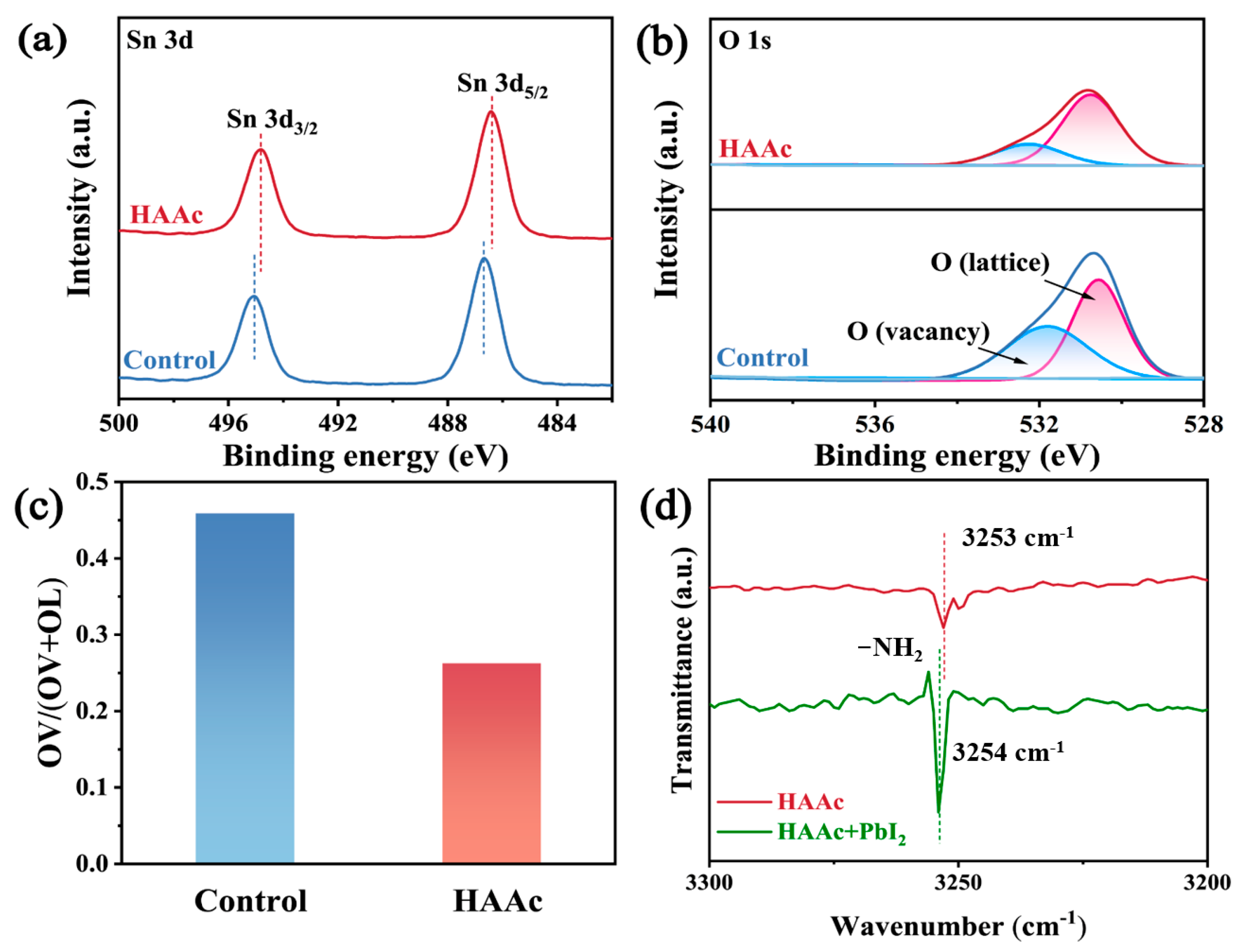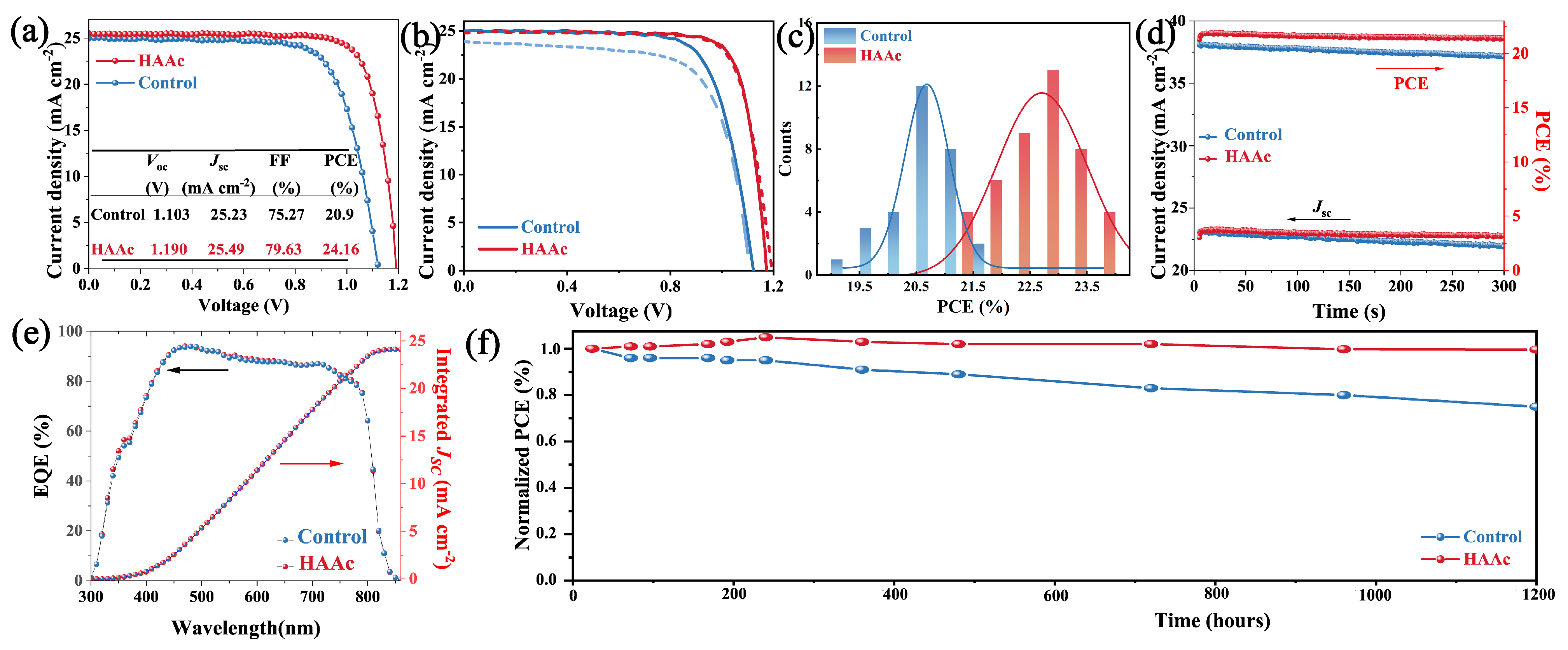Hexylammonium Acetate-Regulated Buried Interface for Efficient and Stable Perovskite Solar Cells
Abstract
:1. Introduction
2. Results and Discussion
3. Conclusions
Supplementary Materials
Author Contributions
Funding
Data Availability Statement
Conflicts of Interest
References
- Zhang, Y.; Zhou, C.; Lin, L.; Pei, F.; Xiao, M.; Yang, X.; Yuan, G.; Zhu, C.; Chen, Y.; Chen, Q. Gelation of Hole Transport Layer to Improve the Stability of Perovskite Solar Cells. Nano-Micro Lett. 2023, 15, 175. [Google Scholar] [CrossRef] [PubMed]
- Huang, F.; Pascoe, A.R.; Wu, W.Q.; Ku, Z.; Peng, Y.; Zhong, J.; Caruso, R.A.; Cheng, Y.B. Effect of the Microstructure of the Functional Layers on the Efficiency of Perovskite Solar Cells. Adv. Mater. 2017, 29, 1601715. [Google Scholar] [CrossRef] [PubMed]
- Chen, Y.; Wang, Q.; Tang, W.; Qiu, W.; Wu, Y.; Peng, Q. Nano Energy Heterocyclic Amino Acid Molecule as a Multifunctional Interfacial Bridge for Improving the Efficiency and Stability of Quadruple Cation Perovskite Solar Cells. Nano Energy 2023, 107, 108154. [Google Scholar] [CrossRef]
- Xiao, Y.; Zhang, H.; Zhao, Y.; Liu, P.; Kondamareddy, K.K.; Wang, C. Carrier Modulation via Tunnel Oxide Passivating at Buried Perovskite Interface for Stable Carbon-Based Solar Cells. Nanomaterials 2023, 13, 2640. [Google Scholar] [CrossRef] [PubMed]
- Kojima, A.; Teshima, K.; Shirai, Y.; Miyasaka, T. Organometal Halide Perovskites as Visible-Light Sensitizers for Photovoltaic Cells. J. Am. Chem. Soc. 2009, 131, 6050–6051. [Google Scholar] [CrossRef] [PubMed]
- Luo, Z.; Guo, T.; Wang, C.; Zou, J.; Wang, J.; Dong, W.; Li, J.; Zhang, W.; Zhang, X.; Zheng, W. Enhancing the Efficiency of Perovskite Solar Cells through Interface Engineering with MoS2 Quantum Dots. Nanomaterials 2022, 12, 3079. [Google Scholar] [CrossRef] [PubMed]
- Ma, Y.; Du, X.; Chen, R.; Zhang, L.; An, Z.; Jen, A.K.Y.; You, J.; Liu, S. Understanding Microstructural Development of Perovskite Crystallization for High Performance Solar Cells. Adv. Mater. 2023, 35, e2306947. [Google Scholar] [CrossRef] [PubMed]
- Li, Z.; Sun, X.; Zheng, X.; Li, B.; Gao, D.; Zhang, S.; Wu, X.; Li, S.; Gong, J.; Luther, J.M.; et al. Stabilized Hole-Selective Layer for High-Performance Inverted p-i-n Perovskite Solar Cells. Science 2023, 382, 284–289. [Google Scholar] [CrossRef] [PubMed]
- Jiang, Q.; Zhang, L.; Wang, H.; Yang, X.; Meng, J.; Liu, H.; Yin, Z.; Wu, J.; Zhang, X.; You, J. Enhanced Electron Extraction Using SnO2 for High-Efficiency Planar-Structure HC(NH2)2 PbI3-Based Perovskite Solar Cells. Nat. Energy 2017, 2, 16177. [Google Scholar] [CrossRef]
- Altinkaya, C.; Aydin, E.; Ugur, E.; Isikgor, F.H.; Subbiah, A.S.; De Bastiani, M.; Liu, J.; Babayigit, A.; Allen, T.G.; Laquai, F.; et al. Tin Oxide Electron-Selective Layers for Efficient, Stable, and Scalable Perovskite Solar Cells. Adv. Mater. 2021, 33, 2005504. [Google Scholar] [CrossRef] [PubMed]
- Yun, A.J.; Kim, J.; Hwang, T.; Park, B. Origins of Efficient Perovskite Solar Cells with Low-Temperature Processed SnO2 Electron Transport Layer. ACS Appl. Energy Mater. 2019, 2, 3554–3560. [Google Scholar] [CrossRef]
- Yoo, J.J.; Seo, G.; Chua, M.R.; Park, T.G.; Lu, Y.; Rotermund, F.; Kim, Y.; Moon, C.S.; Jeon, N.J.; Bulović, V.; et al. Efficient Perovskite Solar Cells via Improved Carrier Management. Nature 2021, 590, 587–593. [Google Scholar] [CrossRef] [PubMed]
- Park, S.Y.; Zhu, K. Advances in SnO2 for Efficient and Stable n–i–p Perovskite Solar Cells. Adv. Mater. 2022, 34, e2110438. [Google Scholar] [CrossRef] [PubMed]
- Wei, J.; Guo, F.; Wang, X.; Xu, K.; Lei, M.; Liang, Y.; Zhao, Y.; Xu, D. SnO2-in-Polymer Matrix for High-Efficiency Perovskite Solar Cells with Improved Reproducibility and Stability. Adv. Mater. 2018, 30, e1805153. [Google Scholar] [CrossRef] [PubMed]
- Chen, J.; Zhao, X.; Kim, S.G.; Park, N.G. Multifunctional Chemical Linker Imidazoleacetic Acid Hydrochloride for 21% Efficient and Stable Planar Perovskite Solar Cells. Adv. Mater. 2019, 31, 1902902. [Google Scholar] [CrossRef] [PubMed]
- Jeong, J.; Kim, M.; Seo, J.; Lu, H.; Ahlawat, P.; Mishra, A.; Yang, Y.; Hope, M.A.; Eickemeyer, F.T.; Kim, M.; et al. Pseudo-Halide Anion Engineering for α-FAPbI3 Perovskite Solar Cells. Nature 2021, 592, 381–385. [Google Scholar] [CrossRef] [PubMed]
- Pham, H.M.; Naqvi, S.D.H.; Tran, H.; Van Tran, H.; Delda, J.; Hong, S.; Jeong, I.; Gwak, J.; Ahn, S.J. Effects of the Electrical Properties of SnO2 and C60 on the Carrier Transport Characteristics of p-i-n-Structured Semitransparent Perovskite Solar Cells. Nanomaterials 2023, 13, 3091. [Google Scholar] [CrossRef] [PubMed]
- Ji, X.; Bi, L.; Fu, Q.; Li, B.; Wang, J.; Jeong, S.Y.; Feng, K.; Ma, S.; Liao, Q.; Lin, F.R.; et al. Target Therapy for Buried Interface Enables Stable Perovskite Solar Cells with 25.05% Efficiency. Adv. Mater. 2023, 35, e2303665. [Google Scholar] [CrossRef] [PubMed]
- Hua, Y.; Feng, Z.; Weng, C.; Chen, X.; Huang, S. Enhancing the Photovoltaic Performance of Perovskite Solar Cells via Ferrocene Dicarboxylic Acid-Doped-Poly(9-Vinylcarbazole) Passivation. J. Mater. Sci. Mater. Electron. 2024, 35, 559. [Google Scholar] [CrossRef]
- Maziviero, F.V.; Melo, D.M.A.; Medeiros, R.L.B.A.; Oliveira, Â.A.S.; Macedo, H.P.; Braga, R.M.; Morgado, E. Advancements and Prospects in Perovskite Solar Cells: From Hybrid to All-Inorganic Materials. Nanomaterials 2024, 14, 332. [Google Scholar] [CrossRef] [PubMed]
- Bu, T.; Liu, X.; Zhou, Y.; Yi, J.; Huang, X.; Luo, L.; Xiao, J.; Ku, Z.; Peng, Y.; Huang, F.; et al. A Novel Quadruple-Cation Absorber for Universal Hysteresis Elimination for High Efficiency and Stable Perovskite Solar Cells. Energy Environ. Sci. 2017, 10, 2509–2515. [Google Scholar] [CrossRef]
- Xing, Y.; Deng, Z.; Wang, Q.; Xiong, J.; Liu, X.; Huang, L.; Zhu, Y.; Zhang, J. Polymer Lewis Base for Improving the Charge Transfer in Tin–Lead Mixed Perovskite Solar Cells. Nanomaterials 2024, 14, 437. [Google Scholar] [CrossRef] [PubMed]
- Park, H.H. Modification of SnO2 Electron Transport Layer in Perovskite Solar Cells. Nanomaterials 2022, 12, 4326. [Google Scholar] [CrossRef] [PubMed]
- Sun, Y.; Pang, Z.; Quan, Y.; Han, D.; Zhang, X.; Ge, X.; Wang, F.; Sun, Y.; Yang, J.; Yang, L. A Synchronous Defect Passivation Strategy for Constructing High-Performance and Stable Planar Perovskite Solar Cells. Chem. Eng. J. 2021, 413, 127387. [Google Scholar] [CrossRef]
- Zhu, P.; Gu, S.; Luo, X.; Gao, Y.; Li, S.; Zhu, J.; Tan, H. Simultaneous Contact and Grain-Boundary Passivation in Planar Perovskite Solar Cells Using SnO2-KCl Composite Electron Transport Layer. Adv. Energy Mater. 2020, 10, 1903083. [Google Scholar] [CrossRef]
- Bi, H.; Liu, B.; He, D.; Bai, L.; Wang, W.; Zang, Z.; Chen, J. Interfacial Defect Passivation and Stress Release by Multifunctional KPF6 Modification for Planar Perovskite Solar Cells with Enhanced Efficiency and Stability. Chem. Eng. J. 2021, 418, 129375. [Google Scholar] [CrossRef]
- Dong, Y.; Shen, W.; Dong, W.; Bai, C.; Zhao, J.; Zhou, Y.; Huang, F.; Cheng, Y.B.; Zhong, J. Chlorobenzenesulfonic Potassium Salts as the Efficient Multifunctional Passivator for the Buried Interface in Regular Perovskite Solar Cells. Adv. Energy Mater. 2022, 12, 2200417. [Google Scholar] [CrossRef]
- Wen, H.; Zhang, Z.; Guo, Y.; Luo, W.; Si, S.; Yin, T.; Wu, H.; Huang, S. Synergistic Full-Scale Defect Passivation Enables High-Efficiency and Stable Perovskite Solar Cells. Adv. Energy Mater. 2023, 13, 2301813. [Google Scholar] [CrossRef]
- Kothandaraman, R.K.; Jiang, Y.; Feurer, T.; Tiwari, A.N.; Fu, F. Correction to: Near-Infrared-Transparent Perovskite Solar Cells and Perovskite-Based Tandem Photovoltaics (Small Methods, (2020), 4, 10, (2000395), 10.1002/Smtd.202000395). Small Methods 2022, 6, 2101538. [Google Scholar] [CrossRef]
- Song, S.; Joon, B.; Hörantner, M.T.; Lim, J.; Kang, G.; Park, M.; Young, J.; Snaith, H.J.; Park, T. Nano Energy Interfacial Electron Accumulation for Ef Fi Cient Homo-Junction Perovskite Solar Cells. Nano Energy 2016, 28, 269–276. [Google Scholar] [CrossRef]
- Wang, F.; Ma, J.; Duan, D.; Liang, X.; Zhou, K.; Sun, Y.; Wang, T.; Yang, G.; Pei, G.; Lin, H.; et al. Tailoring Ionic Liquid Chemical Structure for Enhanced Interfacial Engineering in Two-Step Perovskite Photovoltaics. Small 2023, 2307679. [Google Scholar] [CrossRef] [PubMed]
- Wang, F.; Duan, D.; Zhou, K.; Xue, Y.Z.B.; Liang, X.; Zhou, X.; Ge, C.; Zhou, C.; Xiang, J.; Zhu, J.; et al. Ionic Liquid Engineering Enabled In-plane Orientated 1D Perovskite Nanorods for Efficient Mixed-dimensional Perovskite Photovoltaics. InfoMat 2023, 5, e12459. [Google Scholar] [CrossRef]
- Wang, F.; Duan, D.; Singh, M.; Sutter-Fella, C.M.; Lin, H.; Li, L.; Naumov, P.; Hu, H. Ionic Liquid Engineering in Perovskite Photovoltaics. Energy Environ. Mater. 2023, 6, e12435. [Google Scholar] [CrossRef]
- Xu, C.; Zhang, S.; Fan, W.; Cheng, F.; Sun, H.; Kang, Z.; Zhang, Y. Pushing the Limit of Open-Circuit Voltage Deficit via Modifying Buried Interface in CsPbI3 Perovskite Solar Cells. Adv. Mater. 2023, 35, e2207172. [Google Scholar] [CrossRef] [PubMed]
- Zhuang, Q.; Zhang, C.; Gong, C.; Li, H.; Li, H.; Zhang, Z.; Yang, H.; Chen, J.; Zang, Z. Tailoring Multifunctional Anion Modifiers to Modulate Interfacial Chemical Interactions for Efficient and Stable Perovskite Solar Cells. Nano Energy 2022, 102, 107747. [Google Scholar] [CrossRef]
- Yi, X.; Zhang, Z.; Chang, A.; Mao, Y.; Luan, Y.; Lin, T.; Wei, Y.; Zhang, Y.; Wang, F.; Cao, S.; et al. Incorporating CsF into the PbI2 Film for Stable Mixed Cation-Halide Perovskite Solar Cells. Adv. Energy Mater. 2019, 9, 1901726. [Google Scholar] [CrossRef]
- Sun, Y.; Hu, R.; Wang, F.; Wang, T.; Liang, X.; Zhou, X.; Yang, G.; Li, Y.; Zhang, F.; Zhu, Q.; et al. Ionic Liquid-regulated PbI2 Layer and Defect Passivation for Efficient Perovskite Solar Cells. J. Mater. Chem. C 2024, 12, 5175–5183. [Google Scholar] [CrossRef]
- Guo, H.; Xiang, W.; Fang, Y.; Li, J.; Lin, Y. Molecular Bridge on Buried Interface for Efficient and Stable Perovskite Solar Cells. Angew. Chem. Int. Ed. 2023, 62, e202304568. [Google Scholar] [CrossRef] [PubMed]
- Lee, K.; Huang, Y.; Chiu, W.; Huang, Y.; Chen, G.; Adugna, G.B.; Li, S.; Lin, F.; Lu, S.; Hsieh, H. Fluorinated Pentafulvalene-Fused Hole-Transporting Material Enhances the Performance of Perovskite Solar Cells with Efficiency Exceeding 23%. Adv. Funct. Mater. 2023, 33, 2306367. [Google Scholar] [CrossRef]
- Zhang, H.; Xu, S.; Guo, T.; Du, D.; Tao, Y.; Zhang, L.; Liu, G.; Chen, X.; Ye, J.; Guo, Z.; et al. Dual Effect of Superhalogen Ionic Liquids Ensures Efficient Carrier Transport for Highly Efficient and Stable Perovskite Solar Cells. ACS Appl. Mater. Interfaces 2022, 14, 28826–28833. [Google Scholar] [CrossRef] [PubMed]
- Luo, T.; Ye, G.; Chen, X.; Wu, H.; Zhang, W.; Chang, H. F-Doping-Enhanced Carrier Transport in the SnO2/Perovskite Interface for High-Performance Perovskite Solar Cells. ACS Appl. Mater. Interfaces 2022, 14, 42093–42101. [Google Scholar] [CrossRef] [PubMed]
- Wang, F.; Zhou, K.; Liang, X.; Zhou, X.; Duan, D.; Ge, C.; Zhang, X.; Shi, Y.; Lin, H.; Zhu, Q.; et al. Revealing Size-Dependency of Ionic Liquid to Assist Perovskite Film Formation Mechanism for Efficient and Durable Perovskite Solar Cells. Small Methods 2023, 8, 2300210. [Google Scholar] [CrossRef] [PubMed]
- Hu, R.; Sun, Y.; Li, L.; Wang, T.; Kanda, H.; Liu, C.; Yang, Y.; Huang, S.; Asiri, A.M.; Chu, L.; et al. Crack-Free Monolayer Graphene Interlayer for Improving Perovskite Crystallinity and Energy Level Alignment in Ef Fi Cient Inverted Perovskite Solar Cells. Solar RRL 2022, 6, 2200484. [Google Scholar] [CrossRef]






Disclaimer/Publisher’s Note: The statements, opinions and data contained in all publications are solely those of the individual author(s) and contributor(s) and not of MDPI and/or the editor(s). MDPI and/or the editor(s) disclaim responsibility for any injury to people or property resulting from any ideas, methods, instructions or products referred to in the content. |
© 2024 by the authors. Licensee MDPI, Basel, Switzerland. This article is an open access article distributed under the terms and conditions of the Creative Commons Attribution (CC BY) license (https://creativecommons.org/licenses/by/4.0/).
Share and Cite
Hu, R.; Wang, T.; Wang, F.; Li, Y.; Sun, Y.; Liang, X.; Zhou, X.; Yang, G.; Li, Q.; Zhang, F.; et al. Hexylammonium Acetate-Regulated Buried Interface for Efficient and Stable Perovskite Solar Cells. Nanomaterials 2024, 14, 653. https://doi.org/10.3390/nano14080653
Hu R, Wang T, Wang F, Li Y, Sun Y, Liang X, Zhou X, Yang G, Li Q, Zhang F, et al. Hexylammonium Acetate-Regulated Buried Interface for Efficient and Stable Perovskite Solar Cells. Nanomaterials. 2024; 14(8):653. https://doi.org/10.3390/nano14080653
Chicago/Turabian StyleHu, Ruiyuan, Taomiao Wang, Fei Wang, Yongjun Li, Yonggui Sun, Xiao Liang, Xianfang Zhou, Guo Yang, Qiannan Li, Fan Zhang, and et al. 2024. "Hexylammonium Acetate-Regulated Buried Interface for Efficient and Stable Perovskite Solar Cells" Nanomaterials 14, no. 8: 653. https://doi.org/10.3390/nano14080653




